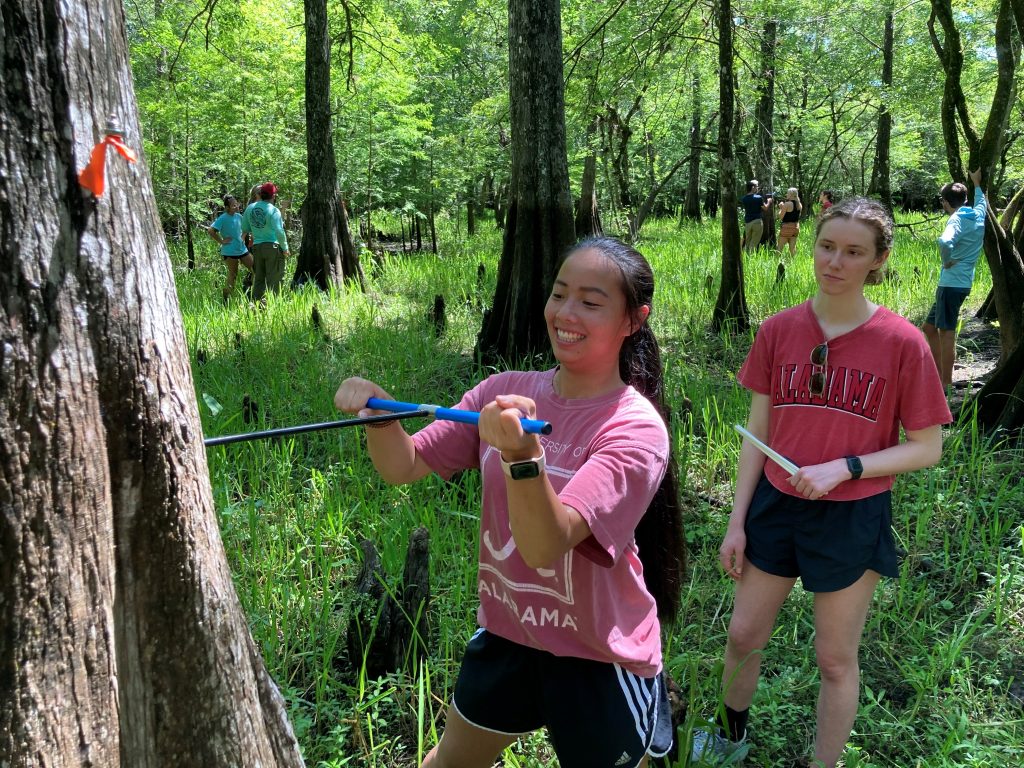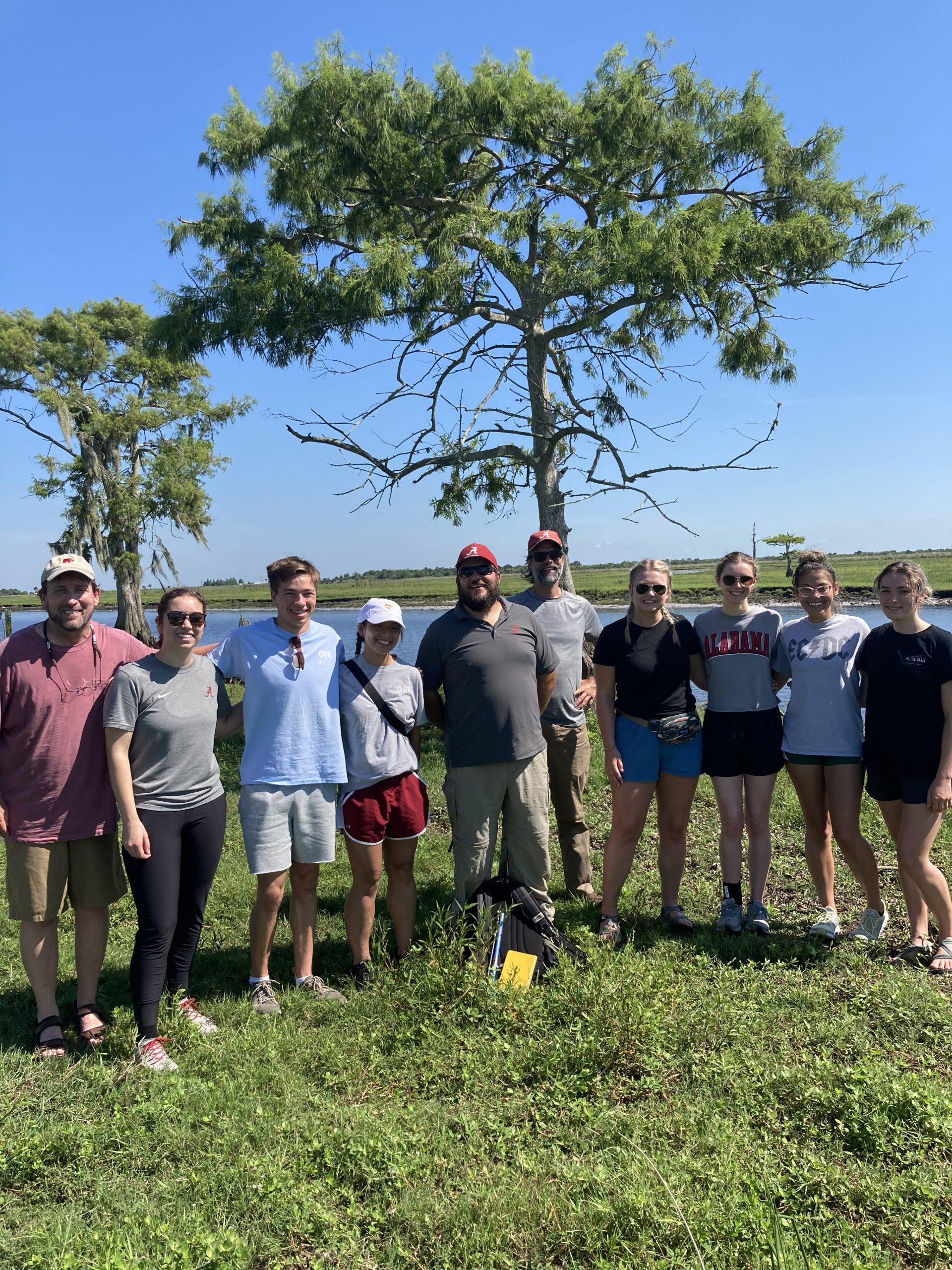
People move to Florida for several reasons, one of them being convenient access to the state’s coastal areas. According to the U.S. Census, the population increased from approximately 9 million people in 1980 to around 22 million in 2020. While the state has plenty of saltwater surrounding it, there’s a concern that freshwater systems might not be able to meet population demands if that growth continues.
That concern has State of Florida officials seeking out alternative freshwater sources: rivers. Thanks to funding from the National Science Foundation’s Research Experience for Undergraduates, or REU, program, researchers and students from The University of Alabama are using the rings inside bald cypress trees to determine if rivers can provide adequate surface water for the future.
“The groundwater wells near the coast provide water to people for personal and agricultural use, but as the population and demand grows, the wells start getting brackish or saltwater intrusion coming in because they’ve been used for so long,” said Dr. Glenn Tootle, a civil engineering professor in UA’s College of Engineering.
Moving the wells further inland may delay saltwater from entering, but the ability for the state’s rivers to deliver and maintain the necessary amount of freshwater is unknown. Tootle, Dr. Matthew Therrell, a dendrochronologist and chair of UA’s Department of Geography, and Dr. Clay Tucker, a postdoctoral researcher in UA’s Department of Geography, recently took seven undergraduate students – four from civil and environmental engineering and one each from biology, geology and environmental sciences – to gather tree cores along the St. Johns River.
The purpose was two-fold: determine if the longest river in Florida has a history of producing enough water to sustain a major population area and to make it an educational outing for their students.
“These real-life experiences make me excited about my future as an environmental engineer,” said Calli Day, a senior at UA. “It is so rewarding to be a part of a research team that will directly benefit the Florida community.”
The St. Johns River flows more than 300 miles between central and eastern Florida, closely winding to the two major metropolitan areas of Orlando and Jacksonville. Tootle, Therrell, Tucker and their team set up a base camp near Orlando where they scouted the bald cypress trees. Students twisted long, hollow metal tubes into the trees, which allowed them to retrieve thin rounded samples of the cores.
The cores were brought back to Therrell’s lab at UA where they used high-resolution scanners and computers to count and measure the size of the rings. In addition to learning the age of the trees, the ring sizes tell them at which points in time they had both plentiful and scarce amounts of water.
Tootle said some of the samples collected dated back to around 1730, but they need additional samples, preferably older trees, to really determine the historical record of waterflow. This discipline is called paleohydrology, the study of streamflow prior to written records. Tapping into the older trees and having that extended historical record is what will tell the tale for Florida’s freshwater future.
“We’d love to get 300 to 500 year records, so the ones we have are shorter than that, but it’s a good preliminary start to where these students are seeing this is how you collect and save the data,” he said. “What we would propose to do is to go back down there, resample those trees and then try to develop a reconstruction of the St. Johns River again to show water managers and planners in the region what we really feel is the long term deliverability of the river.”
The Colorado River Compact of 1922 is one of the reasons to take an extended look through the St. Johns River’s history. That compact was made at a time when the Colorado River’s levels were higher than normal, and water was overallocated to the states served by it. Water shortages are now a constant issue in the western area of the U.S.
“Now we’re finding out based on paleo records that they just so happened to have horrible timing when they did that allocation,” said Tootle. “They can’t sustain that. Paleo studies of tree rings are showing that it does not have that amount of water.”
The same mistake can be avoided in Florida if they can continue to take students there to properly assess historical streamflow patterns. Tootle envisions a long-term program that will provide answers for the state and give undergraduates valuable research experience. It also opens the door for recruiting interested students from all over the country to come to UA where water research has become one of the University’s top focuses.
“Participating in research that has the potential to positively impact communities while still in undergraduate school is invaluable to both personal and professional growth,” said Abigail Phillips, a senior in civil engineering. “Outside of the research field, paleohydrology isn’t a topic that is widely discussed, so it really shows just how many opportunities The University of Alabama has to offer.”
Dr. Steven J. Burian, a civil engineering professor in UA’s College of Engineering, is collaborating with Tootle on a recently received $3 million award from the National Science Foundation Research Traineeship program to provide water resources-focused training to UA graduate students.
“The paleo and water resources research opportunities for graduate students here at UA in engineering and sciences are really world-class,” Burian said. “It’s wonderful to see these opportunities extended to our undergraduate students.”


